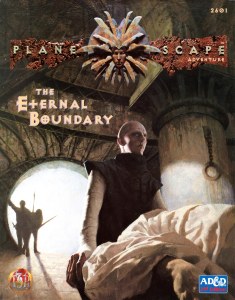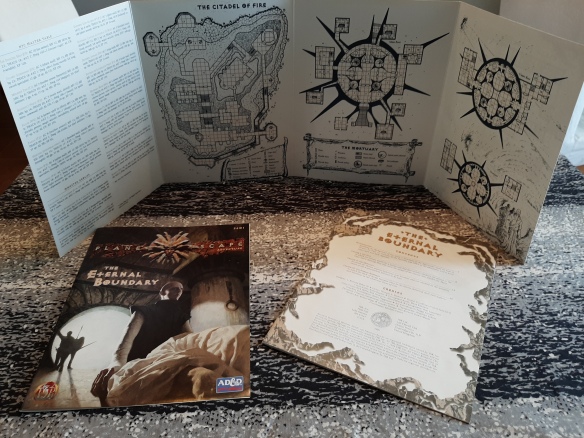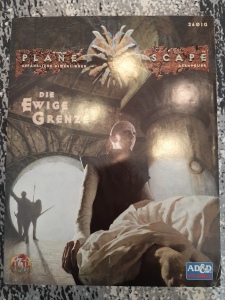It’s been a while since we did one of these, hasn’t it?
 Around a year ago we inaugurated an RPG book club on Facebook and it took me this long to figure I might use the social pressure to get me working on this project again. So, to reiterate, as I am the keeper of a complete collection of the Planescape product line, I will read all of it and jot down my musings.
Around a year ago we inaugurated an RPG book club on Facebook and it took me this long to figure I might use the social pressure to get me working on this project again. So, to reiterate, as I am the keeper of a complete collection of the Planescape product line, I will read all of it and jot down my musings.
A lot has changed since I started these. Nowadays, this stuff is available in PDF on DriveThruRPG, with product histories written by Shannon Appelcline. I will be drawing on those histories as I go. I also noticed that the blog Guile’s World has created conversions of Planescape things for Pathfinder 1E, which I’ll be linking as we go along. The Eternal Boundary’s conversion is here.
Here we go, then. I chose The Eternal Boundary, partly because it’s a short 32-page adventure and I could get through it in an hour even while taking notes, and partly because it was the first adventure module published for Planescape, coming out in June 1994. Its product code 2601 is the next one from Planescape Campaign Setting.
Incidentally, an in-depth look into its bowels will contain SPOILERS.
The Eternal Boundary is written by L. Richard Baker III, who according to Wikipedia is the same person as the Rich Baker or Richard Baker who worked on a lot of AD&D, D&D and Alternity stuff as well as some of the better Forgotten Realms novels like the Last Mythal trilogy and City of Ravens.
The first thing that strikes about this thing is that production-wise, they weren’t messing around. It comes with its own DM screen, with NPC stats and dungeon maps on the DM side and art, a tavern map and a map of the Hive on the player side. The adventure itself is a coverless booklet.
Plot and Structure
The adventure’s background is that a wizard by the name of Green Marvent, based in the gate town Plague-Mort, is hatching a cunning plan to destabilize the kriegstanz and become a real shaker in Sigil. It’s a bit on the convoluted side, but the basic idea is that his agents pick out barmies in the Hive – the mentally ill, beggars, people nobody will miss – and take them out with a spell called feign death, which makes them appear, well, dead. They’re then taken to the Mortuary, where Marvent’s agent on the inside flings them through a portal to the Elemental Plane of Fire, ostensibly for cremation but really into a base run by other agents, who take the knocked-out barmies, reprogram them by telling them they’re dead but have a second chance at life, and give them orders to go to Sigil and join a faction. Marvent would then use these sleeper agents to do something that’s not described in detail. Green Marvent’s outfit is named the Illuminated, and they’re what we would call a sect.
The adventure is meant for low-level characters, levels 1st-3rd according to the text, 1st-5th according to the back cover. I checked my German-language copy, which says “Die Ewige Grenze is geeignet für eine Gruppe von 4-6 Charakteren der Stufen 1-5″, so I guess that settles it. This makes sense, first adventure and everything, and it kinda also works as an introduction to Planescape. It’s not a Grand Tour of the Planes kind of thing, but starts off slow. I figure a playthrough would take some four to six hours, depending on how quick the players are on the uptake and how much fighting they end up doing. In my judgement, this could be run as a one-shot.
The Eternal Boundary is structured into three parts, “The Hive, “The Mortuary” and “The Eternal Boundary”. In “The Hive”, they are hired to look for a person. It depends on party composition which introduction they get. If there are no faction members or only members of the Dustmen, the Bleak Cabal, or the Xaositects, they get the no-faction intro, and otherwise they get the faction start. This is because those three factions are deeply involved in the plot and especially having a Dustman in the party can shortcut most of the second part.
As a side note, it’s always felt to me like some of the factions are more NPC groups than others, and these three are on the NPC-ey end of the scale. I will talk more about this once we reach Factol’s Manifesto.
Anyway, they’re hired to look up a Hiver by name of Eliath because he has information about a demiplane called the Isle of Black Trees. This is funny to me because Planescape: Torment was later developed by Black Isle Studios. Anyway, by meeting people they should be able to figure out Eliath was killed recently and taken to the Mortuary.
“Should” is the operative word here. AD&D wasn’t the best system for running investigations and the DM is advised to just give them the map with hotspots and then throw encounters at them. They will meet Dustmen and Chaosmen and/or Bleakers, and a barmy local who “dies”. The Bleakers and Chaosmen are investigating the deaths and may decide that the PCs are either guilty or impeding the investigation. They will eventually be assaulted by the Shadowknave, Green Marvent’s catspaw, and his gang.
Hopefully, the party eventually figures out they need to investigate the Mortuary, which brings us to Part II, “The Mortuary”. First, though, they will be informed by their boss that Eliath has been spotted alive, and will hopefully look him up and interrogate him (among the things they can find out is that the Isle of Black Trees is a dead end with him). They’ll also encounter the barmy they saw “die” in the Hive, now going by another name and a member of a party member’s faction.
At this point, the party should have enough railroad track built to figure out there’s something sketchy going on at the Mortuary, so the next thing is to infiltrate it. Hopefully infiltrate, because a frontal assault will result in character deaths. Getting caught, on the other hand, will shortcut the entire second part of the adventure, since whoever catches them will either be Illuminated or hand them over to the Illuminated undercover agent. Unless they come clean to Factol Skall, who will conduct an investigation of his own and “dispose” of the PCs, which feels like bad design to me and I would have Skall throw the PCs at the problem on the philosophy that if it doesn’t make the problem go away, at least the PCs did.
The Mortuary is basically presented as a dungeon crawl instead of a more reasonable format for an infiltration mission, which I suppose is understandable considering the book reads AD&D and 1994, but does take up a lot of space. Incidentally, the Mortuary presented here is basically the same as the Mortuary of Planescape: Torment, with in some cases not only precisely the same floorplan but also the same encounters.
The problem with Part II is that by my reading, the clues the PCs go into the Mortuary with are pretty thin. They’ll have “the Mortuary” and possibly “Elemental Plane of Fire”, but unless they have a particularly kleptomaniac outlook and go to a specific crypt, they will not discover the agent’s name. These are always a bit hard to see just by reading the text, but to my eye the investigation does not flow naturally.
Anyway, one way or another they will end up through the gate to the Elemental Plane of Fire and the Citadel of Fire. The setup implies a few ways for them to go about this such as infiltration, but the end result is likely going to be an assault. At this point the party will likely have enough information to piece together what’s going on and will try to end it. There’s a boss, a githzerai fighter/mage named Imogen, to fight who will demonstrate admirable initiative once she figures out there are intruders, and will gather a team to seek and destroy them. This makes speed imperative – the more enemies the party can take out before Imogen gathers up her posse, the fewer members it will have. I like the crew in the Citadel of Fire. There’s a nice variety of adversaries. I have no idea what the stone golem is doing in a low-level adventure, though. By my reading, they’re not supposed to fight it, but it’s there and under the control of Imogen, which is weird.
The ideal ending is presented as destroying the life support gem, rescuing the prisoners, and returning to Sigil. What bothers me is what’s not presented. Green Marvent’s whole plot isn’t laid out very well, which makes failure or partial failure harder to adjudicate. The Eternal Boundary also doesn’t present options for follow-up. It’s like it’s written as the first part of a series but there are no sequels. Green Marvent, the evil mastermind, is never encountered. While he’s mentioned in the Plague-Mort entries in Planescape Campaign Setting and later in Well of Worlds, there’s no follow-up that I’ve been able to find. Reading this is like watching a story through a keyhole. I have a constant awareness of missing context.
Summary
The Eternal Boundary is the first place where we encounter the concept of sects. Not quite as large, or powerful, or as Sigil-centered as the factions, they’re similar, significant power groups. Some of them have a governing philosophy of some kind, some – like the Illuminated – are mostly just a bunch of thugs. We will be formally introduced to sects in Planes of Chaos.
Another thing that struck me with its absence was Tony DiTerlizzi’s art. There are three full-page colour illustrations of a Sigil street, the Mortuary, and the Citadel of Fire, by Rick Berry, Ned Dameron, and Alan Pollack. The cover, portraying a Mortuary zombie with a number on his forehead, is by Robh Ruppel. I like it as an atmosphere piece but it is a bit drab.
So, there it is, The Eternal Boundary. I feel it is more interesting as a resource on the Mortuary than as an adventure module. Indeed, if its description of the Mortuary hadn’t been so detailed, I think it could’ve accommodated more immediately usable material such as more a more thorough description of the Illuminated and a rundown of Green Marvent’s masterplan. If you want a starred review, 3/5.
Next up: Monstrous Compendium Planescape Appendix I, unless someone convinces me otherwise.




I’ve run The Eternal Boundary to start off three separate Planescape campaigns, and it’s one of my all-time favorite modules. Like many DMs, I’ve found Planescape difficult to write for. My love for the setting has forced me to overcome the difficulty, but I find I lean more on published content in these campaigns than in any other setting.
I’ve always considered Green Marvent a purposely empty slate, for use as a long-term nemesis for the party–a sort of wide open opportunity in the spirit of Keep on the Borderlands and similar early D&D products. I’m definitely curious about the scheme as it existed in the mind of the author, but in the three times I’ve run the adventure, I never reached a point of having to describe the plan’s details. Sleeper agents among the various factions are valuable enough, even in the absence of a detailed and rigid conspiracy, I think.
Really looking forward to this series continuing. In the meantime, I hope you don’t mind me sharing a link to my recent series detailing examples of interesting faction NPCs:
https://blogofhexes.blogspot.com/2018/05/character-concepts-planescape-pt-1.html
Ooh, this’ll be fun to follow. Can’t wait 😀
That’s interesting, DM Theseus. Have you run the module in systems other than AD&D 2E? I’m giving thought to running it myself to see how it functions in practice, probably in Pathfinder 1E, and am giving some thought to the possible level range. My first instinct would be to write up pregens at 1st level and level them up after each part is completed.